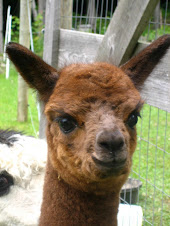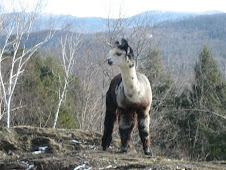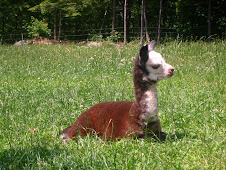Tuesday, March 16, 2010
Do the Rot Thing - Composting Your Camelid Manure 101
Human society and its agriculture depend on the health of the soil and water. Your alpaca manure can either be an asset to your farm or a contaminant to the environment. By employing simple on-farm composting techniques you can easily turn your manure into a marketable product or integrate it back into your farm in as little as 120-360 days.
Identifying a Composting Site on Your Farm
The quality of your composting site will have a significant impact on the ease of pile management and the quality of the compost produced. Considerations in choosing your site:
• What will you be composting (manure, hay, other?) and where on the farm will that material be coming from? Obviously, the shortest distance to travel with the materials is desired. If you are composting materials other than the waste from your farm it may require a permit.
• Will you compost throughout the winter or have an active summer pile and a winter stock pile?
• You will need enough space to begin a pile that is mountainous in shape with a convex top, 3-8 feet high and 6-15 feet in width at the base. The pile will be turned over the course of several weeks so that the entire pile has been turned over itself and is now in a new location.
• Will you turn your pile by shovel or bucket loader? If bucket loader, then you will need space to move about with the equipment.
• A sunny location speeds up the process.
Follow the minimum recommendations for environmental protection.
• Min. distance to bedrock: 3-6 feet
• Min to ground water: 1-1/2-3 feet
• Distance to property boundary or public roads: 100 feet unless permission is obtained.
• Distance to wells, springs, surface waters or wetlands: 25-100 feet upslope and 300 feet downslope of the pile. (A site should not be located in an area with potential for flooding.)
• Site slope: 2-3% grade is ideal, 1.5-6% tolerable
The Recipe
You are striving for approximately 60% moisture content and a ratio of 25-30 parts carbon per 1 part nitrogen (C:N - 25-30:1). This will create the habitat and diet for your decomposer populations (earthworms, microorganisms, etc). While it is important to understand how the recipe is arrived at, I don’t recommend going through a six-page worksheet of calculations to create compost on your farm. Below is a simplified version of how the recipe is arrived at followed by a very simplified estimate of what you want your hay/bedding to manure ratio to be.
1. Carbon to Nitrogen Ratio - Bedding to Manure Ratio
• Manure – what is the carbon/nitrogen makeup of your manure? You can have it tested or you can approximate C:N – 16:1.
• Bedding – this is usually a carbon component (paper, hay, straw, cardboard). Again, you can have it tested or estimate it to be C:N – 45:1.
• Ratio of bedding to manure – From the above you can see that your manure already has a high level of carbon as does the bedding. Now you just need to get the right mixture. After factoring in moisture content to the above two figures the calculations would bring you to a ratio of about .32 pounds of bedding to 1 pound of manure (or Bedding:Manure – 32:100) Simplified even further this comes out to be roughly 1 part bedding to just over 3 parts manure. In the summer months this means you will need to add (1 part) bedding to (3 parts) manure if scooped directly from pasture piles. Although it would seem that your winter pile would have too much bedding and not enough manure, remember that you are adding moisture/urine. The winter mix will likely be correct but after monitoring it can be amended.
2. Moisture Content – this is critical to the pile health and a good method of determining if you are getting your C:N ratio correct. To monitor, dig 12” deep into the pile and grab a handful of material and squeeze. If it is:
• Dripping = too moist (about 65%+ moisture content, want 60%)
• Damp and glistening = Ideal 60%
• Crumbling = too dry (below 60%)
• Sniff – if it has a gassy smell it is too moist or too much Nitrogen (manure)
Turning
You should plan on turning the pile about once a week. Turn pile ¼ at a time by taking material from the side and dumping it on top. Your pile should, again, be a mountainous shape with a convex top after you have turned it. Continue turning ¼ at a time until the pile resembles loose crumbly dark soil. It should take about 3 months in the spring/summer months. An alternative to turning it yourself would be to pasture pigs with your pile. They’ll be in hog heaven and you will too as they do the turning for you!
Pile Monitoring
Ideally you would do this every time you walk by the pile; at a minimum once a week.
1. Temperature – you want it to reach 130 degrees w/in a few days to a week. It will need to stay at this temp. for several days to kill pathogens and seeds. You can monitor with a 3’ probe thermometer or dig in and if too hot to touch you’re over 120 degrees. If it is excessively hot you are killing your decomposers.
2. Moisture – Look at the pile and reach in and take a handful and squeeze. Is it dripping, glistening, crumbly? Add more bedding if too wet or manure if too dry. Open top to allow rain in if too dry.
3. Odor – smell the pile as you work it and inspect for moisture. It should smell earthy. If it doesn’t it means it is either too low in carbon (bedding) or low in oxygen (too moist or too dense).
4. Visual Inspection – Dry? Damp? Crusting on the surface (reduces available air in pile)?
The Finished Product
Curing – After composting is finished, allow your pile to cure for 1-3 months. Make sure it is covered.
Testing – you can test your finished product so that you know how you did or what you are spreading on your pastures or to aid in commanding an excellent price for it.
Ideas for Selling
Bag it in used feed bags and sell to local gardeners or place an ad on Craig’s List for someone to buy and take away the whole pile. Top dress your pastures in the fall and you will have lush pastures in the spring. Just price a bag of “Moo Doo” (composted cow manure) and you’ll know how valuable your composted manure is!
Simplified into 5 Easy Steps
1. Recipe - Pile your manure and bedding in a mountainous heap with a convex top in a ratio of 1 part bedding to a little more than 3 parts manure.
2. Turn – Turn your pile over itself ¼ at a time once a week for 3+ months til done.
3. Monitor your pile – feel, look, smell to see if you have the right mix.
4. Cure – after you have made “dirt”, cover it and let it cure for 1-3 months depending on the time of year.
5. Harvest – Use or sell this valuable resource generated by your farm’s waste! And feel good that you “Did the Rot Thing” for the environment by composting!
Identifying a Composting Site on Your Farm
The quality of your composting site will have a significant impact on the ease of pile management and the quality of the compost produced. Considerations in choosing your site:
• What will you be composting (manure, hay, other?) and where on the farm will that material be coming from? Obviously, the shortest distance to travel with the materials is desired. If you are composting materials other than the waste from your farm it may require a permit.
• Will you compost throughout the winter or have an active summer pile and a winter stock pile?
• You will need enough space to begin a pile that is mountainous in shape with a convex top, 3-8 feet high and 6-15 feet in width at the base. The pile will be turned over the course of several weeks so that the entire pile has been turned over itself and is now in a new location.
• Will you turn your pile by shovel or bucket loader? If bucket loader, then you will need space to move about with the equipment.
• A sunny location speeds up the process.
Follow the minimum recommendations for environmental protection.
• Min. distance to bedrock: 3-6 feet
• Min to ground water: 1-1/2-3 feet
• Distance to property boundary or public roads: 100 feet unless permission is obtained.
• Distance to wells, springs, surface waters or wetlands: 25-100 feet upslope and 300 feet downslope of the pile. (A site should not be located in an area with potential for flooding.)
• Site slope: 2-3% grade is ideal, 1.5-6% tolerable
The Recipe
You are striving for approximately 60% moisture content and a ratio of 25-30 parts carbon per 1 part nitrogen (C:N - 25-30:1). This will create the habitat and diet for your decomposer populations (earthworms, microorganisms, etc). While it is important to understand how the recipe is arrived at, I don’t recommend going through a six-page worksheet of calculations to create compost on your farm. Below is a simplified version of how the recipe is arrived at followed by a very simplified estimate of what you want your hay/bedding to manure ratio to be.
1. Carbon to Nitrogen Ratio - Bedding to Manure Ratio
• Manure – what is the carbon/nitrogen makeup of your manure? You can have it tested or you can approximate C:N – 16:1.
• Bedding – this is usually a carbon component (paper, hay, straw, cardboard). Again, you can have it tested or estimate it to be C:N – 45:1.
• Ratio of bedding to manure – From the above you can see that your manure already has a high level of carbon as does the bedding. Now you just need to get the right mixture. After factoring in moisture content to the above two figures the calculations would bring you to a ratio of about .32 pounds of bedding to 1 pound of manure (or Bedding:Manure – 32:100) Simplified even further this comes out to be roughly 1 part bedding to just over 3 parts manure. In the summer months this means you will need to add (1 part) bedding to (3 parts) manure if scooped directly from pasture piles. Although it would seem that your winter pile would have too much bedding and not enough manure, remember that you are adding moisture/urine. The winter mix will likely be correct but after monitoring it can be amended.
2. Moisture Content – this is critical to the pile health and a good method of determining if you are getting your C:N ratio correct. To monitor, dig 12” deep into the pile and grab a handful of material and squeeze. If it is:
• Dripping = too moist (about 65%+ moisture content, want 60%)
• Damp and glistening = Ideal 60%
• Crumbling = too dry (below 60%)
• Sniff – if it has a gassy smell it is too moist or too much Nitrogen (manure)
Turning
You should plan on turning the pile about once a week. Turn pile ¼ at a time by taking material from the side and dumping it on top. Your pile should, again, be a mountainous shape with a convex top after you have turned it. Continue turning ¼ at a time until the pile resembles loose crumbly dark soil. It should take about 3 months in the spring/summer months. An alternative to turning it yourself would be to pasture pigs with your pile. They’ll be in hog heaven and you will too as they do the turning for you!
Pile Monitoring
Ideally you would do this every time you walk by the pile; at a minimum once a week.
1. Temperature – you want it to reach 130 degrees w/in a few days to a week. It will need to stay at this temp. for several days to kill pathogens and seeds. You can monitor with a 3’ probe thermometer or dig in and if too hot to touch you’re over 120 degrees. If it is excessively hot you are killing your decomposers.
2. Moisture – Look at the pile and reach in and take a handful and squeeze. Is it dripping, glistening, crumbly? Add more bedding if too wet or manure if too dry. Open top to allow rain in if too dry.
3. Odor – smell the pile as you work it and inspect for moisture. It should smell earthy. If it doesn’t it means it is either too low in carbon (bedding) or low in oxygen (too moist or too dense).
4. Visual Inspection – Dry? Damp? Crusting on the surface (reduces available air in pile)?
The Finished Product
Curing – After composting is finished, allow your pile to cure for 1-3 months. Make sure it is covered.
Testing – you can test your finished product so that you know how you did or what you are spreading on your pastures or to aid in commanding an excellent price for it.
Ideas for Selling
Bag it in used feed bags and sell to local gardeners or place an ad on Craig’s List for someone to buy and take away the whole pile. Top dress your pastures in the fall and you will have lush pastures in the spring. Just price a bag of “Moo Doo” (composted cow manure) and you’ll know how valuable your composted manure is!
Simplified into 5 Easy Steps
1. Recipe - Pile your manure and bedding in a mountainous heap with a convex top in a ratio of 1 part bedding to a little more than 3 parts manure.
2. Turn – Turn your pile over itself ¼ at a time once a week for 3+ months til done.
3. Monitor your pile – feel, look, smell to see if you have the right mix.
4. Cure – after you have made “dirt”, cover it and let it cure for 1-3 months depending on the time of year.
5. Harvest – Use or sell this valuable resource generated by your farm’s waste! And feel good that you “Did the Rot Thing” for the environment by composting!
Thursday, March 11, 2010
Taking Care of the Rumen
We’ve all experienced it at some point - some major stress in our life or we’ve altered our diet less than gradually or taken medication or something as simple as drinking different water while on vacation and it results in serious digestive upset! Well, alpacas are just as susceptible or more so to gastrointestinal upset than we are. While discussing alpaca digestion can be quite involved, I’ll attempt to offer a few simple ways to ward off potential problems.
Digestive Flora
Scientists estimate that we humans have trillions of microbes (bacteria, viruses, fungi and assorted parasites) living on the outside of our body and hundreds of millions in our digestive tract. Our bodies coexist with these living microscopic organisms, keeping us healthy most of the time and helping us digest and absorb vitamins and minerals from our food and water. These microorganisms (bacteria, protozoa, fungi, etc) are also teaming within the alpaca.
The population dynamics of the different species found in the forestomach will depend on the alpaca’s diet. This brings me to my first Tip: Avoid abruptly changing the diet for exactly this reason – the microorganisms are specific to the diet. If you change the diet abruptly the alpaca now has a population that is designed to serve a different diet and they can wreak havoc while simultaneously the forestomach has no population of the microorganisms to work with the new diet. This results in stress and a gastrointestinal challenge for the animal.
Stress
Stress impacts all the physiological systems including gastrointestinal function and health. Stresses such as: too much heat or cold; too much, too little or the wrong kind of food; aggressive companions or crowded conditions or transport and shows can lead to digestive tract problems such as colic, constipation, urinary tract problems, parasite problems, ulcers and so on. These range in seriousness from mild to life threatening. Tips: As their keepers this is one of our tasks – stress management. We can also breed for this trait choosing alpacas that are not compromised under stressful conditions. Always be alert for signs of digestive tract upset such as reluctance to eat, reluctance to stand, diarrhea, constipation, gut ache, self-isolation, change in eating habits, and food preference.
Parasites and Deworming
Parasites are one of the most important considerations in the digestive and overall health of the alpaca. We’d need an entire article to address this completely. But here are a few tips that can keep parasites in check. Tips: Keep stocking density low per pen; pasture rotation is a must; when necessary use dry lot feeding to help control a parasite problem; quarantine animals coming onto the farm; keep animals in good condition; and run fecal exams on a regular basis. For deworming - Tips: It is best to treat the individual animal not the herd. Giving dewormers to animals that don’t need them only upsets their digestive flora unnecessarily and encourages parasite resistance to the drug. Also consider giving probiotics after any medical treatment to encourage the reestablishment of gut flora.
Water
Water is one, if not the most essential, nutrient critical to proper digestion. Fresh, clean, high-quality water should be available for free choice at all times. Tips: Abrupt changes in water can lead to digestive troubles. Consider bringing your own water to shows, in transport and when relocating an alpaca to a new farm. It could make all the difference in your animal’s health during this stressful time.
Feed
It’s worth the time it takes to learn how to determine if feed is of good quality. While there are so many factors, there is one simple thing to know that can make a world of difference for your alpacas. Tip: Have you ever eaten a lettuce from a plant that has bolted (gone to seed)? It tastes horrible, it’s difficult to digest, and has poorer nutritional content than an immature plant. The same holds true for your hay and pasture grasses. Always try and put animals on immature pasture (mow if necessary) and the same for hay.
Crias and Weaning
The newborn cria is a nonruminant animal. Milk is digested in the third compartment whereas in an adult about 50%+ of digestion takes place in the forestomach or first compartment. It takes the cria about 12 weeks to ruminate as an adult and even then only at about 80-90% of adult function. Tip: Before weaning make sure you have observed healthy ruminant activity, then gradually wean the cria from the dam (together at night but not daytime). If transitioning to a new farm consider weaning at 5-6 months and observe healthy behavior and digestive function before the cria leaves the farm. Also, the temperament of the alpaca and the situation it will be going to will greatly impact their success at weaning and the impact it will have on their digestive upset.
Other Tips
• At changes of season gradually put on pasture and take off.
• Consider having hay from the same source available at all times so that the alpaca can use this as its base of food at all times while taking in new food (different pastures or moving to a new farm).
• Avoid forced grazing where the selection of food is limited and scarce. They will eat things that upset them before starving.
• Be very careful to not let alpacas get into grain bins causing potential forestomach acidosis. Use bungee cords to secure them closed.
• Gradually change grain products or hay.
• Consider bringing all your own hay, water and grain to shows or to send along with an animal relocating to it’s new farm.
• Sit and watch your herd for 5-10 minutes a day to make sure they are eating, ruminating and pooping/peeing normally.
Summary
High quality feed and water – gradual changes – manage stress.
Karen Nicholson, of Stepping Stone Farm Alpacas in Stowe, VT, has a herd of eight colorful alpacas bred and managed for valued production traits including: fiber excellence, conformation, reproductive vigor, hardiness and temperament. Also on the farm are: two French Alpine dairy goats, Indian Runner ducks, broiler chickens and several laying hens all integrated into their farm management program. While the information shared is not meant to replace the protocol set up by your veterinarian these methods are being successfully used with many different types of livestock including camelids. Any comments or questions can be directed to: Karen@stowealpacas.com
Digestive Flora
Scientists estimate that we humans have trillions of microbes (bacteria, viruses, fungi and assorted parasites) living on the outside of our body and hundreds of millions in our digestive tract. Our bodies coexist with these living microscopic organisms, keeping us healthy most of the time and helping us digest and absorb vitamins and minerals from our food and water. These microorganisms (bacteria, protozoa, fungi, etc) are also teaming within the alpaca.
The population dynamics of the different species found in the forestomach will depend on the alpaca’s diet. This brings me to my first Tip: Avoid abruptly changing the diet for exactly this reason – the microorganisms are specific to the diet. If you change the diet abruptly the alpaca now has a population that is designed to serve a different diet and they can wreak havoc while simultaneously the forestomach has no population of the microorganisms to work with the new diet. This results in stress and a gastrointestinal challenge for the animal.
Stress
Stress impacts all the physiological systems including gastrointestinal function and health. Stresses such as: too much heat or cold; too much, too little or the wrong kind of food; aggressive companions or crowded conditions or transport and shows can lead to digestive tract problems such as colic, constipation, urinary tract problems, parasite problems, ulcers and so on. These range in seriousness from mild to life threatening. Tips: As their keepers this is one of our tasks – stress management. We can also breed for this trait choosing alpacas that are not compromised under stressful conditions. Always be alert for signs of digestive tract upset such as reluctance to eat, reluctance to stand, diarrhea, constipation, gut ache, self-isolation, change in eating habits, and food preference.
Parasites and Deworming
Parasites are one of the most important considerations in the digestive and overall health of the alpaca. We’d need an entire article to address this completely. But here are a few tips that can keep parasites in check. Tips: Keep stocking density low per pen; pasture rotation is a must; when necessary use dry lot feeding to help control a parasite problem; quarantine animals coming onto the farm; keep animals in good condition; and run fecal exams on a regular basis. For deworming - Tips: It is best to treat the individual animal not the herd. Giving dewormers to animals that don’t need them only upsets their digestive flora unnecessarily and encourages parasite resistance to the drug. Also consider giving probiotics after any medical treatment to encourage the reestablishment of gut flora.
Water
Water is one, if not the most essential, nutrient critical to proper digestion. Fresh, clean, high-quality water should be available for free choice at all times. Tips: Abrupt changes in water can lead to digestive troubles. Consider bringing your own water to shows, in transport and when relocating an alpaca to a new farm. It could make all the difference in your animal’s health during this stressful time.
Feed
It’s worth the time it takes to learn how to determine if feed is of good quality. While there are so many factors, there is one simple thing to know that can make a world of difference for your alpacas. Tip: Have you ever eaten a lettuce from a plant that has bolted (gone to seed)? It tastes horrible, it’s difficult to digest, and has poorer nutritional content than an immature plant. The same holds true for your hay and pasture grasses. Always try and put animals on immature pasture (mow if necessary) and the same for hay.
Crias and Weaning
The newborn cria is a nonruminant animal. Milk is digested in the third compartment whereas in an adult about 50%+ of digestion takes place in the forestomach or first compartment. It takes the cria about 12 weeks to ruminate as an adult and even then only at about 80-90% of adult function. Tip: Before weaning make sure you have observed healthy ruminant activity, then gradually wean the cria from the dam (together at night but not daytime). If transitioning to a new farm consider weaning at 5-6 months and observe healthy behavior and digestive function before the cria leaves the farm. Also, the temperament of the alpaca and the situation it will be going to will greatly impact their success at weaning and the impact it will have on their digestive upset.
Other Tips
• At changes of season gradually put on pasture and take off.
• Consider having hay from the same source available at all times so that the alpaca can use this as its base of food at all times while taking in new food (different pastures or moving to a new farm).
• Avoid forced grazing where the selection of food is limited and scarce. They will eat things that upset them before starving.
• Be very careful to not let alpacas get into grain bins causing potential forestomach acidosis. Use bungee cords to secure them closed.
• Gradually change grain products or hay.
• Consider bringing all your own hay, water and grain to shows or to send along with an animal relocating to it’s new farm.
• Sit and watch your herd for 5-10 minutes a day to make sure they are eating, ruminating and pooping/peeing normally.
Summary
High quality feed and water – gradual changes – manage stress.
Karen Nicholson, of Stepping Stone Farm Alpacas in Stowe, VT, has a herd of eight colorful alpacas bred and managed for valued production traits including: fiber excellence, conformation, reproductive vigor, hardiness and temperament. Also on the farm are: two French Alpine dairy goats, Indian Runner ducks, broiler chickens and several laying hens all integrated into their farm management program. While the information shared is not meant to replace the protocol set up by your veterinarian these methods are being successfully used with many different types of livestock including camelids. Any comments or questions can be directed to: Karen@stowealpacas.com
Subscribe to:
Posts (Atom)








